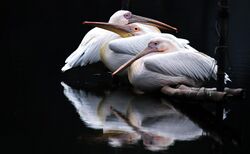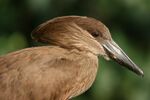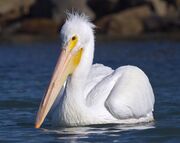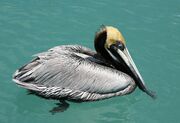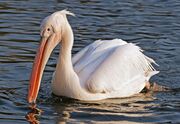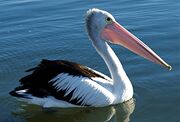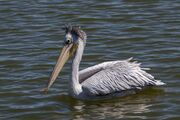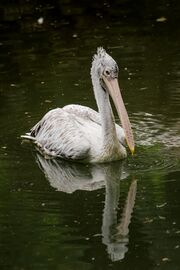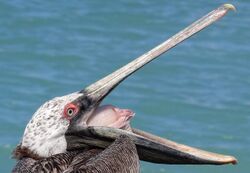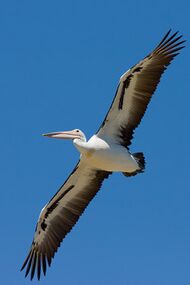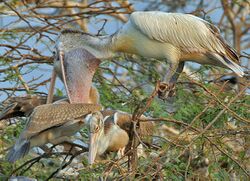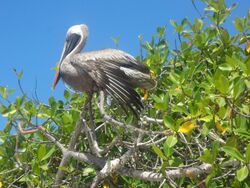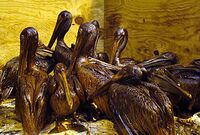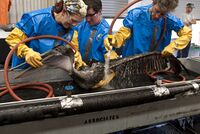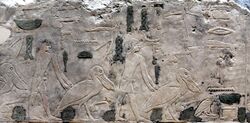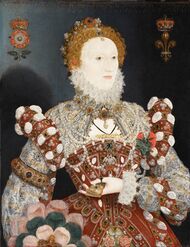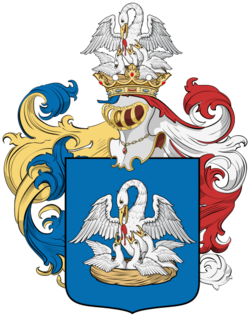Biology:Pelican
| Pelican | |
|---|---|
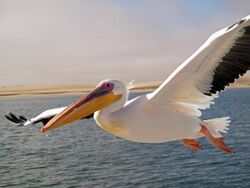
| |
| A great white pelican in breeding condition flying over Walvis Bay, Namibia. | |
| Scientific classification | |
| Domain: | Eukaryota |
| Kingdom: | Animalia |
| Phylum: | Chordata |
| Class: | Aves |
| Order: | Pelecaniformes |
| Family: | Pelecanidae |
| Genus: | Pelecanus Linnaeus, 1758 |
| Type species | |
| Pelecanus onocrotalus Linnaeus, 1758
| |
| Species | |
|
8, see text | |
Pelicans (genus Pelecanus) are a genus of large water birds that make up the family Pelecanidae. They are characterized by a long beak and a large throat pouch used for catching prey and draining water from the scooped-up contents before swallowing. They have predominantly pale plumage, except for the brown and Peruvian pelicans. The bills, pouches, and bare facial skin of all pelicans become brightly coloured before the breeding season.
The eight living pelican species have a patchy, seasonally-dependent yet global distribution, ranging latitudinally from the tropics to the temperate zone. Pelicans are absent from interior Amazonian South America, from polar regions and the open ocean; at least one species is known to migrate to the inland desert of Australia 's Red Centre, after heavy rains create temporary lakes. White pelicans are also observed at the American state of Utah's Great Salt Lake, for example, some 600 miles (965 km) from the nearest coastline (the Pacific West Coast). They have also been seen hundreds of miles inland in North America, having flown northwards along the Mississippi River and other large waterways.
Long thought to be related to frigatebirds, cormorants, tropicbirds, and gannets and boobies, pelicans instead are most closely related to the shoebill and hamerkop storks (although these two birds are not actually true 'storks'), and are placed in the order Pelecaniformes. Ibises, spoonbills, herons, and bitterns have been classified in the same order. Fossil evidence of pelicans dates back at least 36 million years to the remains of a tibiotarsus recovered from late Eocene strata of Egypt that bears striking similarity to modern species of pelican.[1] They are thought to have evolved in the Old World and spread into the Americas; this is reflected in the relationships within the genus as the eight species divide into Old World and New World lineages.[3] This hypothesis is supported by fossil evidence from the oldest pelican taxa.[1]
Pelicans will frequent inland waterways but are most known for residing along maritime and coastal zones, where they feed principally on fish in their large throat pouches, diving into the water and catching them at/near the water's surface. They can adapt to varying degrees of water salinity, from freshwater and brackish to—most commonly—seawater. They are gregarious birds, travelling in flocks, hunting cooperatively, and breeding colonially. Four white-plumaged species tend to nest on the ground, and four brown or grey-plumaged species nest mainly in trees.[4] The relationship between pelicans and people has often been contentious. The birds have been persecuted because of their perceived competition with commercial and recreational fishing.[5] Their populations have fallen through habitat destruction, disturbance, and environmental pollution, and three species are of conservation concern. They also have a long history of cultural significance in mythology, and in Christian and heraldic iconography.
Taxonomy and systematics
Etymology
The name comes from the Ancient Greek word pelekan (πελεκάν),[6] which is itself derived from the word pelekys (πέλεκυς) meaning "axe".[7] In classical times, the word was applied to both the pelican and the woodpecker.[8]
The genus Pelecanus was first formally described by Carl Linnaeus in his landmark 1758 10th edition of Systema Naturae. He described the distinguishing characteristics as a straight bill hooked at the tip, linear nostrils, a bare face, and fully webbed feet. This early definition included frigatebirds, cormorants, and sulids, as well as pelicans.[9]
Taxonomy
The family Pelecanidae was introduced (as Pelicanea) by the French polymath Constantine Samuel Rafinesque in 1815.[10][11] Pelicans give their name to the Pelecaniformes, an order which has a varied taxonomic history. Tropicbirds, darters, cormorants, gannets, boobies, and frigatebirds, all traditional members of the order, have since been reclassified: tropicbirds into their own order, Phaethontiformes, and the remainder into the Suliformes. In their place, herons, ibises, spoonbills, the hamerkop, and the shoebill have now been transferred into the Pelecaniformes.[12] Molecular evidence suggests that the shoebill and the hamerkop form a sister group to the pelicans,[13] though some doubt exists as to the exact relationships among the three lineages.[14]
The oldest known record of Pelicans is a right tibiotarsus very similar to those of modern species from the Birket Qarun Formation in the Wadi El Hitan in Egypt, dating to the late Eocene (Priabonian), referred to the genus Eopelecanus.[1]
| |||||||||||||||||||||||||||||||||||||||||||||
| Evolutionary relationships among the extant species based on Kennedy et al. (2013).[3] |
|
Living species
The eight living pelican species were traditionally divided into two groups, one containing four ground-nesters with mainly white adult plumage (Australian, Dalmatian, great white, and American white pelicans), and one containing four grey- or brown-plumaged species which nest preferentially either in trees (pink-backed, spot-billed and brown pelicans), or on sea rocks (Peruvian pelican). The largely marine brown and Peruvian pelicans, formerly considered conspecific,[4] are sometimes separated from the others by placement in the subgenus Leptopelecanus[15] but in fact species with both sorts of appearance and nesting behavior are found in either.
DNA sequencing of both mitochondrial and nuclear genes yielded quite different relationships; the three New World pelicans formed one lineage, with the American white pelican sister to the two brown pelicans, and the five Old World species the other. The Dalmatian, pink-backed, and spot-billed were all closely related to one another, while the Australian white pelican was their next-closest relative. The great white pelican also belonged to this lineage, but was the first to diverge from the common ancestor of the other four species. This finding suggests that pelicans evolved in the Old World and spread into the Americas, and that preference for tree- or ground-nesting is more related to size than genetics.[3]
| Common name | Scientific name and subspecies | Range | Size and ecology | IUCN status and estimated population |
|---|---|---|---|---|
| American white pelican | Pelecanus erythrorhynchos Gmelin, 1789 |
Breeds in inland Canada and United States, wintering in southern United States, Mexico and Central America.[17][18]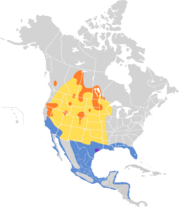
|
Size: Length 1.3–1.8 m (4.3–5.9 ft), wingspan 2.44–2.9 m (8.0–9.5 ft), weight 5–9 kg (10–20 lb).[19] Plumage almost entirely white, except for black primary and secondary remiges only visible in flight. Habitat: Diet: |
LC |
| Brown pelican | Pelecanus occidentalis Linnaeus, 1766 |
Coastal distribution ranging from North America and the Caribbean to northern South America and the Galapagos.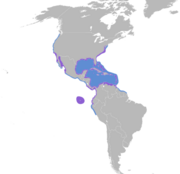
|
Size: Length up to 1.4 m (4.6 ft), wingspan 2–2.3 m (6.6–7.5 ft), weight 3.6–4.5 kg (7.9–9.9 lb).[20] Smallest pelican; distinguished by brown plumage; feeds by plunge-diving.[21] Habitat: Diet: |
LC |
| Peruvian pelican | Pelecanus thagus Molina, 1782 |
Pacific Coast of South America from Ecuador and Peru south through to southern Chile.[23]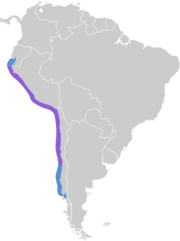
|
Size: Length up to 1.52 m (5.0 ft), wingspan 2.48 m (8.1 ft),[24] average weight 7 kg (15 lb).[25] Dark with a white stripe from the crown down the sides of the neck. Habitat: Diet: |
NT |
| Great white pelican | Pelecanus onocrotalus Linnaeus, 1758 |
Patchy distribution from eastern Mediterranean east to Indochina and Malay Peninsula, and south to South Africa.[23]
|
Size: {{{size}}} Habitat: Diet: |
LC |
| Australian pelican | Pelecanus conspicillatus Temminck, 1824 |
Australia and New Guinea; vagrant to New Zealand, Solomons, Bismarck Archipelago, Fiji and Wallacea.[23]
|
Size: Length 1.60–1.90 m (5.2–6.2 ft), wingspan 2.3–2.5 m (7.5–8.2 ft), weight 4–8.2 kg (8.8–18.1 lb).[28] Predominantly white with black along primaries and very large, pale pink bill. Habitat: Diet: |
LC |
| Pink-backed pelican | Pelecanus rufescens Gmelin, 1789 |
Africa, Seychelles and southwestern Arabia;[23] extinct in Madagascar.[30]
|
Size: Length 1.25–1.32 m (4.1–4.3 ft), wingspan 2.65–2.9 m (8.7–9.5 ft),[31] weight 3.9–7 kg (8.6–15.4 lb).[32] Grey and white plumage, occasionally pinkish on the back, with a yellow upper mandible and grey pouch.[31] Habitat: Diet: |
LC |
| Dalmatian pelican | Pelecanus crispus Bruch, 1832 |
South-eastern Europe to India and China.[23]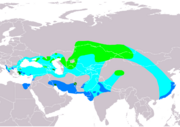
|
Size: Length 1.60–1.80 m (5.2–5.9 ft), wingspan 2.70–3.20 m (8.9–10.5 ft), weight 10–12 kg (22–26 lb).[34][35] Largest pelican; differs from great white pelican in having curly nape feathers, grey legs and greyish-white plumage.[31] Habitat: Diet: |
NT |
| Spot-billed pelican | Pelecanus philippensis Gmelin, 1789 |
Southern Asia from southern Pakistan across India east to Indonesia;[23] extinct in the Philippines and possibly eastern China.[37] Status: near threatened.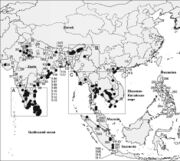
|
Size: Length 1.27–1.52 m (4.2–5.0 ft), wingspan 2.5 m (8.2 ft), weight c. 5 kg (11 lb).[37] Mainly grey-white all over, with a grey hindneck crest in breeding season, pinkish rump and spotted bill pouch.[37] Habitat: Diet: |
NT |
Fossil record
The fossil record shows that the pelican lineage has existed for at least 36 million years; the oldest known pelican fossil was assigned to Eopelecanus aegyptiacus and was found in late Eocene (middle to late part of the early Priabonian stage/age) deposits of the Birket Qarun Formation within the Wadi Al-Hitan World Heritage Site in Egypt.[1] A more complete fossil pelican of early Oligocene age is known from deposits at the Luberon in southeastern France, and is remarkably similar to modern forms.[39] Its beak is almost complete and is morphologically identical to that of present-day pelicans, showing that this advanced feeding apparatus was already in existence at the time.[39] An Early Miocene fossil has been named Miopelecanus gracilis on the basis of certain features originally considered unique, but later thought to lie within the range of interspecific variation in Pelecanus.[39] The Late Eocene Protopelicanus may be a pelecaniform or suliform – or a similar aquatic bird such as a pseudotooth (Pelagornithidae), but is not generally considered a pelecanid.[40][1] The supposed Miocene pelican Liptornis from Patagonia is a nomen dubium (of doubtful validity), being based on fragments providing insufficient evidence to support a valid description.[41]
Fossil finds from North America have been meagre compared with Europe, which has a richer fossil record.[42] Several Pelecanus species have been described from fossil material, including:[43]
- Pelecanus cadimurka, Rich & van Tets, 1981 (Late Pliocene, South Australia)[44]
- Pelecanus cautleyi, Davies, 1880 (Early Pliocene, Siwalik Hills, India)[43]
- Pelecanus fraasi, Lydekker, 1891 (Middle Miocene, Bavaria, Germany)[43]
- Pelecanus gracilis, Milne-Edwards, 1863 (Early Miocene, France) (see: Miopelecanus)[43]
- Pelecanus halieus, Wetmore, 1933 (Late Pliocene, Idaho, US)[45]
- Pelecanus intermedius, Fraas, 1870 (Middle Miocene, Bavaria, Germany)[43] (transferred to Miopelecanus by Cheneval in 1984)
- Pelecanus odessanus, Widhalm, 1886 (Late Miocene, near Odesa, Ukraine)[46]
- Pelecanus paranensis, Noriega et. al., 2023 (Late Miocene, Entre Ríos Province, Argentina)[47]
- Pelecanus schreiberi, Olson, 1999 (Early Pliocene, North Carolina, US)[42]
- Pelecanus sivalensis, Davies, 1880 (Early Pliocene, Siwalik Hills, India)[43]
- Pelecanus tirarensis, Miller, 1966 (Late Oligocene to Middle Miocene, South Australia)[48]
Description

Pelicans are very large birds with very long bills characterised by a downcurved hook at the end of the upper mandible, and the attachment of a huge gular pouch to the lower. The slender rami of the lower bill and the flexible tongue muscles form the pouch into a basket for catching fish, and sometimes rainwater,[15] though to not hinder the swallowing of large fish, the tongue itself is tiny.[50] They have a long neck and short stout legs with large, fully webbed feet. Although they are among the heaviest of flying birds,[51] they are relatively light for their apparent bulk because of air pockets in the skeleton and beneath the skin, enabling them to float high in the water.[15] The tail is short and square. The wings are long and broad, suitably shaped for soaring and gliding flight, and have the unusually large number of 30 to 35 secondary flight feathers.[52]
Males are generally larger than females and have longer bills.[15] The smallest species is the brown pelican, small individuals of which can be no more than 2.75 kg (6.1 lb) and 1.06 m (3.5 ft) long, with a wingspan of as little as 1.83 m (6.0 ft). The largest is believed to be the Dalmatian, at up to 15 kg (33 lb) and 1.83 m (6.0 ft) in length, with a maximum wingspan of 3 m (9.8 ft). The Australian pelican's bill may grow up to 0.5 m (1.6 ft) long in large males,[53] the longest of any bird.[4]
Pelicans have mainly light-coloured plumage, the exceptions being the brown and Peruvian pelicans.[54] The bills, pouches, and bare facial skin of all species become brighter before breeding season commences.[55] The throat pouch of the Californian subspecies of the brown pelican turns bright red, and fades to yellow after the eggs are laid, while the throat pouch of the Peruvian pelican turns blue. The American white pelican grows a prominent knob on its bill that is shed once females have laid eggs.[5] The plumage of immature pelicans is darker than that of adults.[54] Newly hatched chicks are naked and pink, darkening to grey or black after 4 to 14 days, then developing a covering of white or grey down.[56]
Air sacs
Anatomical dissections of two brown pelicans in 1939 showed that pelicans have a network of air sacs under their skin situated across the ventral surface including the throat, breast, and undersides of the wings, as well as having air sacs in their bones.[57] The air sacs are connected to the airways of the respiratory system, and the pelican can keep its air sacs inflated by closing its glottis, but how air sacs are inflated is not clear.[57] The air sacs serve to keep the pelican remarkably buoyant in the water[58] and may also cushion the impact of the pelican's body on the water surface when they dive from flight into water to catch fish.[57] Superficial air sacs may also help to round body contours (especially over the abdomen, where surface protuberances may be caused by viscera changing size and position) to enable the overlying feathers to form more effective heat insulation and also to enable feathers to be held in position for good aerodynamics.[57]
Distribution and habitat
Modern pelicans are found on all continents except Antarctica. They primarily inhabit warm regions, although breeding ranges extend to latitudes of 45° South (Australian pelicans in Tasmania) and 60° North (American white pelicans in western Canada).[4] Birds of inland and coastal waters, they are absent from polar regions, the deep ocean, oceanic islands (except the Galapagos), and inland South America, as well as from the eastern coast of South America from the mouth of the Amazon River southwards.[15] Subfossil bones have been recovered from as far south as New Zealand's South Island,[59] although their scarcity and isolated occurrence suggests that these remains may have merely been vagrants from Australia (much as is the case today).[60]
Behaviour and ecology
Pelicans swim well with their strong legs and their webbed feet. They rub the backs of their heads on their preen glands to pick up an oily secretion, which they transfer to their plumage to waterproof it.[4] Holding their wings only loosely against their bodies, pelicans float with relatively little of their bodies below the water surface.[31] They dissipate excess heat by gular flutter – rippling the skin of the throat and pouch with the bill open to promote evaporative cooling.[15] They roost and loaf communally on beaches, sandbanks, and in shallow water.[15]
A fibrous layer deep in the breast muscles can hold the wings rigidly horizontal for gliding and soaring. Thus, they use thermals for soaring to heights of 3000 m (10,000 ft) or more,[61] combined both with gliding and with flapping flight in V formation, to commute distances up to 150 km (93 mi) to feeding areas.[4] Pelicans also fly low (or "skim") over stretches of water, using a phenomenon known as ground effect to reduce drag and increase lift. As the air flows between the wings and the water surface, it is compressed to a higher density and exerts a stronger upward force against the bird above.[62] Hence, substantial energy is saved while flying.[63]
Adult pelicans rely on visual displays and behaviour to communicate,[64] particularly using their wings and bills. Agonistic behaviour consists of thrusting and snapping at opponents with their bills, or lifting and waving their wings in a threatening manner.[65] Adult pelicans grunt when at the colony, but are generally silent elsewhere or outside breeding season.[31][66][67][68] Conversely, colonies are noisy, as chicks vocalise extensively.[64]
Breeding and lifespan
Pelicans are gregarious and nest colonially. Pairs are monogamous for a single season, but the pair bond extends only to the nesting area; mates are independent away from the nest. The ground-nesting (white) species have a complex communal courtship involving a group of males chasing a single female in the air, on land, or in the water while pointing, gaping, and thrusting their bills at each other. They can finish the process in a day. The tree-nesting species have a simpler process in which perched males advertise for females.[4] The location of the breeding colony is constrained by the availability of an ample supply of fish to eat, although pelicans can use thermals to soar and commute for hundreds of kilometres daily to fetch food.[55]
The Australian pelican has two reproductive strategies depending on the local degree of environmental predictability. Colonies of tens or hundreds, rarely thousands, of birds breed regularly on small coastal and subcoastal islands where food is seasonally or permanently available. In arid inland Australia, especially in the endorheic Lake Eyre basin, pelicans breed opportunistically in very large numbers of up to 50,000 pairs, when irregular major floods, which may be many years apart, fill ephemeral salt lakes and provide large amounts of food for several months before drying out again.[61]
In all species, copulation takes place at the nest site; it begins shortly after pairing and continues for 3–10 days before egg-laying. The male brings the nesting material, in ground-nesting species (which may not build a nest) sometimes in the pouch, and in tree-nesting species crosswise in the bill. The female then heaps the material up to form a simple structure.[4]
The eggs are oval, white, and coarsely textured.[15] All species normally lay at least two eggs; the usual clutch size is one to three, rarely up to six.[15] Both sexes incubate with the eggs on top of or below the feet; they may display when changing shifts. Incubation takes 30–36 days;[15] hatching success for undisturbed pairs can be as high as 95%, but because of sibling competition or siblicide, in the wild, usually all but one nestling dies within the first few weeks (later in the pink-backed and spot-billed species). Both parents feed their young. Small chicks are fed by regurgitation; after about a week, they are able to put their heads into their parents' pouches and feed themselves.[56] Sometimes before, but especially after being fed the pelican chick may seem to "throw a tantrum" by loudly vocalizing and dragging itself around in a circle by one wing and leg, striking its head on the ground or anything nearby and the tantrums sometimes end in what looks like a seizure that results in the chick falling briefly unconscious; the reason is not clearly known, but a common belief is that it is to draw attention to itself and away from any siblings who are waiting to be fed.[4]
Parents of ground-nesting species sometimes drag older young around roughly by the head before feeding them. From about 25 days old,[15] the young of these species gather in "pods" or "crèches" of up to 100 birds in which parents recognise and feed only their own offspring. By 6–8 weeks they wander around, occasionally swimming, and may practise communal feeding.[4] Young of all species fledge 10–12 weeks after hatching. They may remain with their parents afterwards, but are now seldom or never fed. They are mature at three or four years old.[15] Overall breeding success is highly variable.[4] Pelicans live for 15 to 25 years in the wild, although one reached an age of 54 years in captivity.[55]
Feeding
The diet of pelicans usually consists of fish,[55] but occasionally amphibians, turtles, crustaceans, insects, birds, and mammals are also eaten.[69][70][71] The size of the preferred prey fish varies depending on pelican species and location. For example, in Africa, the pink-backed pelican generally takes fish ranging in size from fry up to 400 g (0.9 lb) and the great white pelican prefers somewhat larger fish, up to 600 g (1.3 lb), but in Europe, the latter species has been recorded taking fish up to 1,850 g (4.1 lb).[71] In deep water, white pelicans often fish alone. Nearer the shore, several encircle schools of small fish or form a line to drive them into the shallows, beating their wings on the water surface and then scooping up the prey.[72] Although all pelican species may feed in groups or alone, the Dalmatian, pink-backed, and spot-billed pelicans are the only ones to prefer solitary feeding. When fishing in groups, all pelican species have been known to work together to catch their prey, and Dalmatian pelicans may even cooperate with great cormorants.[71]
File:Pelecanus occidentalis -Jamaica -fishing-8.ogv Large fish are caught with the bill-tip, then tossed up in the air to be caught and slid into the gullet head-first. A gull will sometimes stand on the pelican's head, peck it to distraction, and grab a fish from the open bill.[73] Pelicans in their turn sometimes snatch prey from other waterbirds.[4]
The brown pelican usually plunge-dives head-first for its prey, from a height as great as 10–20 m (33–66 ft), especially for anchovies and menhaden.[74][72][71] The only other pelican to feed using a similar technique is the Peruvian pelican, but its dives are typically from a lower height than the brown pelican.[75] The Australian and American white pelicans may feed by low plunge-dives landing feet-first and then scooping up the prey with the beak, but they—as well as the remaining pelican species—primarily feed while swimming on the water.[71] Aquatic prey is most commonly taken at or near the water surface.[54] Although principally a fish eater, the Australian pelican is also an eclectic and opportunistic scavenger and carnivore that forages in landfill sites, as well as taking carrion[76] and "anything from insects and small crustaceans to ducks and small dogs".[76] Food is not stored in a pelican's throat pouch, contrary to popular folklore.[55]
Pelicans may also eat birds. In southern Africa, eggs and chicks of the Cape cormorant are an important food source for great white pelicans.[71] Several other bird species have been recorded in the diet of this pelican in South Africa, including Cape gannet chicks on Malgas Island[77] as well as crowned cormorants, kelp gulls, greater crested terns, and African penguins on Dassen Island and elsewhere.[78] The Australian pelican, which is particularly willing to take a wide range of prey items, has been recorded feeding on young Australian white ibis, and young and adult grey teals and silver gulls.[71][79] Brown pelicans have been reported preying on young common murres in California and the eggs and nestlings of cattle egrets and nestling great egrets in Baja California, Mexico.[80] Peruvian pelicans in Chile have been recorded feeding on nestlings of imperial shags, juvenile Peruvian diving petrels, and grey gulls.[81][82] Cannibalism of chicks of their own species is known from the Australian, brown, and Peruvian pelicans.[79][80][82] Non-native great white pelicans have been observed swallowing city pigeons in St. James's Park in London, England.[70]
Status and conservation
Populations
Globally, pelican populations are adversely affected by these main factors: declining supplies of fish through overfishing or water pollution, destruction of habitat, direct effects of human activity such as disturbance at nesting colonies, hunting and culling, entanglement in fishing lines and hooks, and the presence of pollutants such as DDT and endrin. Most species' populations are more or less stable, although three are classified by the IUCN as being at risk. All species breed readily in zoos, which is potentially useful for conservation management.[83]
The combined population of brown and Peruvian pelicans is estimated at 650,000 birds, with around 250,000 in the United States and Caribbean, and 400,000 in Peru.[lower-alpha 1] The National Audubon Society estimates the global population of the brown pelican at 300,000.[85] Numbers of brown pelican plummeted in the 1950s and 1960s, largely as a consequence of environmental DDT pollution, and the species was listed as endangered in the US in 1970. With restrictions on DDT use in the US from 1972, its population has recovered, and it was delisted in 2009.[84][86]
The Peruvian pelican is listed as near threatened because, although the population is estimated by BirdLife International to exceed 500,000 mature individuals, and is possibly increasing, it has been much higher in the past. It declined dramatically during the 1998 El Niño event and could experience similar declines in the future. Conservation needs include regular monitoring throughout the range to determine population trends, particularly after El Niño years, restricting human access to important breeding colonies, and assessing interactions with fisheries.[87]
The spot-billed pelican has an estimated population between 13,000 and 18,000 and is considered to be near threatened in the IUCN Red List of Threatened Species. Numbers declined substantially during the 20th century, one crucial factor being the eradication of the important Sittaung valley breeding colony in Burma through deforestation and the loss of feeding sites.[88] The chief threats it faces are from habitat loss and human disturbance, but populations have mostly stabilised following increased protection in India and Cambodia.[38]
The pink-backed pelican has a large population ranging over much of sub-Saharan Africa. In the absence of substantial threats or evidence of declines across its range, its conservation status is assessed as being of least concern. Regional threats include the drainage of wetlands and increasing disturbance in southern Africa. The species is susceptible to bioaccumulation of toxins and the destruction of nesting trees by logging.[89]
The American white pelican has increased in numbers,[5] with its population estimated at over 157,000 birds in 2005, becoming more numerous east of the continental divide, while declining in the west.[90] However, whether its numbers have been affected by exposure to pesticides is unclear, as it has also lost habitat through wetland drainage and competition with recreational use of lakes and rivers.[5]
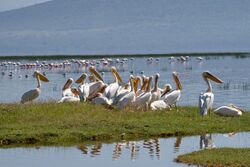
Great white pelicans range over a large area of Africa and southern Asia. The overall trend in numbers is uncertain, with a mix of regional populations that are increasing, declining, stable, or unknown, but no evidence has been found of rapid overall decline, and the status of the species is assessed as being of least concern. Threats include the drainage of wetlands, persecution and sport hunting, disturbance at the breeding colonies, and contamination by pesticides and heavy metals.[91]
The Dalmatian pelican has a population estimated at between 10,000 and 20,000 following massive declines in the 19th and 20th centuries. The main ongoing threats include hunting, especially in eastern Asia, disturbance, coastal development, collision with overhead power lines, and the over-exploitation of fish stocks.[92] It is listed as near threatened by the IUCN Red List of Threatened Species as the population trend is downwards, especially in Mongolia, where it is nearly extinct. However, several European colonies are increasing in size and the largest colony for the species, at the Small Prespa Lake in Greece, has reached about 1,400 breeding pairs following conservation measures.[36]
Widespread across Australia,[5] the Australian pelican has a population generally estimated at between 300,000 and 500,000 individuals.[93] Overall population numbers fluctuate widely and erratically depending on wetland conditions and breeding success across the continent. The species is assessed as being of least concern.[94]
Culling and disturbance
Pelicans have been persecuted by humans for their perceived competition for fish, despite the fact that their diet overlaps little with fish caught by people.[5] Starting in the 1880s, American white pelicans were clubbed and shot, their eggs and young were deliberately destroyed, and their feeding and nesting sites were degraded by water management schemes and wetland drainage.[5] Even in the 21st century, an increase in the population of American white pelicans in southeastern Idaho in the US was seen to threaten the recreational cutthroat trout fishery there, leading to official attempts to reduce pelican numbers through systematic harassment and culling.[95]
Great white pelicans on Dyer Island, in the Western Cape region of South Africa, were culled during the 19th century because their predation of the eggs and chicks of guano-producing seabirds was seen to threaten the livelihood of the guano collectors.[78] More recently, such predation at South African seabird colonies has impacted on the conservation of threatened seabird populations, especially crowned cormorants, Cape cormorants, and bank cormorants. This has led to suggestions that pelican numbers should be controlled at vulnerable colonies.[78]
Apart from habitat destruction and deliberate, targeted persecution, pelicans are vulnerable to disturbance at their breeding colonies by birdwatchers, photographers, and other curious visitors. Human presence alone can cause the birds to accidentally displace or destroy their eggs, leave hatchlings exposed to predators and adverse weather, or even abandon their colonies completely.[96][97][98]
Poisoning and pollution
DDT pollution in the environment was a major cause of decline of brown pelican populations in North America in the 1950s and 1960s. It entered the oceanic food web, contaminating and accumulating in several species, including one of the pelican's primary food fish – the northern anchovy. Its metabolite DDE is a reproductive toxicant in pelicans and many other birds, causing eggshell thinning and weakening, and consequent breeding failure through the eggs being accidentally crushed by brooding birds. Since an effective ban on the use of DDT was implemented in the US in 1972, the eggshells of breeding brown pelicans there have thickened and their populations have largely recovered.[74][99]
In the late 1960s, following the major decline in brown pelican numbers in Louisiana from DDT poisoning, 500 pelicans were imported from Florida to augment and re-establish the population; over 300 subsequently died in April and May 1975 from poisoning by the pesticide endrin.[100] About 14,000 pelicans, including 7500 American white pelicans, perished from botulism after eating fish from the Salton Sea in 1990.[5] In 1991, abnormal numbers of brown pelicans and Brandt's cormorants died at Santa Cruz, California, when their food fish (anchovies) were contaminated with neurotoxic domoic acid, produced by the diatom Pseudo-nitzschia.[101]
As waterbirds that feed on fish, pelicans are highly susceptible to oil spills, both directly by being oiled and by the impact on their food resources. A 2007 report to the California Fish and Game Commission estimated that during the previous 20 years, some 500–1000 brown pelicans had been affected by oil spills in California.[98] A 2011 report by the Center for Biological Diversity, a year after the April 2010 Deepwater Horizon oil spill, said that 932 brown pelicans had been collected after being affected by oiling and estimated that 10 times that number had been harmed as a result of the spill.[102]
Where pelicans interact with fishers, through either sharing the same waters or scavenging for fishing refuse, they are especially vulnerable to being hooked and entangled in both active and discarded fishing lines. Fish hooks are swallowed or catch in the skin of the pouch or webbed feet, and strong monofilament fishing line can become wound around bill, wings, or legs, resulting in crippling, starvation, and often death. Local rescue organisations have been established in North America and Australia by volunteers to treat and rehabilitate injured pelicans and other wildlife.[103][104][105]
Parasites and disease
As with other bird families, pelicans are susceptible to a variety of parasites. Avian malaria is carried by the mosquito Culex pipens, and high densities of these biting insects may force pelican colonies to be abandoned. Leeches may attach to the vent or sometimes the inside of the pouch.[106] A study of the parasites of the American white pelican found 75 different species, including tapeworms, flukes, flies, fleas, ticks, and nematodes.
The brown pelican has a similarly extensive range of parasites. The nematodes Contracaecum multipapillatum and C. mexicanum and the trematode Ribeiroia ondatrae have caused illness and mortality in the Puerto Rican population, possibly endangering the pelican on this island.[107]
Many pelican parasites are found in other bird groups, but several lice are very host-specific.[108] Healthy pelicans can usually cope with their lice, but sick birds may carry hundreds of individuals, which hastens a sick bird's demise. The pouch louse Piagetiella peralis occurs in the pouch and so it cannot be removed by preening. While this is usually not a serious problem even when present in such numbers that it covers the whole interior of the pouch, sometimes inflammation and bleeding may occur from it and harm the host.[108]
In May 2012, hundreds of Peruvian pelicans were reported to have perished in Peru from a combination of starvation and roundworm infestation.[109]
Religion, mythology, and popular culture
The pelican (henet in Egyptian) was associated in Ancient Egypt with death and the afterlife. It was depicted in art on the walls of tombs, and figured in funerary texts, as a protective symbol against snakes. Henet was also referred to in the Pyramid Texts as the "mother of the king" and thus seen as a goddess. References in nonroyal funerary papyri show that the pelican was believed to possess the ability to prophesy safe passage in the underworld for someone who had died.[110]
In Jewish dietary law, pelican is not considered kosher (fit for consumption), as it is a type of seabird and therefore considered an unclean animal.[111][112]
An origin myth from the Murri people of Queensland, cited by Andrew Lang, describes how the Australian pelican acquired its black and white plumage. The story tells that the pelican was once a black bird. During a flood, he made a canoe to save drowning people. He fell in love with a woman and decided to save her, but she and her friends tricked him and escaped. The pelican consequently began preparing to go to war against them by daubing himself with white clay as war paint. Before he had finished, another pelican, on seeing such a strange piebald creature, killed him with its beak, and all such pelicans have been black and white ever since.[113]
The Moche people of ancient Peru worshipped nature.[114] They placed emphasis on animals and often depicted pelicans in their art.[115]
Alcatraz Island was given its name by the Spanish because of the large numbers of brown pelicans nesting there. The word alcatraz is itself derived from the Arabic al-caduos, a term used for a water-carrying vessel and likened to the pouch of the pelican. The English name albatross is also derived by corruption of the Spanish word.[116][117]
Christianity

The Physiologus, a didactic Christian text from the 3rd or 4th century, claims that pelicans kill their young when they grow and strike their parents in the face, but then the mother laments them for three days, after which she strikes her side and brings them back to life with her blood.[118] The Physiologus explains this as mirroring the pain inflicted on God by people's idolatry, and the self-sacrifice of Jesus on the cross which redeems the sinful (see the blood and water gushing from the wound in his side).[118] This text was widely copied, translated, and sometimes closely paraphrased during the Middle Ages, for instance by 13th-century authors Guillaume le Clerc and Bartholomaeus Anglicus.[118]
In a newer, also medieval version of the European myth, the pelican was thought to be particularly attentive to her young, to the point of providing them with blood by wounding her own breast when no other food was available. As a result, the pelican came to symbolise the Passion of Jesus and the Eucharist,[119][120] supplementing the image of the lamb and the flag.[121] This mythical characteristic is referenced in the hymn "Adoro te devote" ("Humbly We Adore Thee"), where in the penultimate verse, Saint Thomas Aquinas describes Christ as the loving divine pelican, one drop of whose blood can save the world.[122] Similarly, the 1678 Christian allegorical novel The Pilgrim’s Progress describes how “the pelican pierce[s] her own breast with her bill … to nourish her young ones with her blood, and thereby to show that Christ the blessed so loveth his young, his people, as to save them from death by his blood.”[123]
Elizabeth I of England adopted the symbol, portraying herself as the "mother of the Church of England". A portrait of her called the Pelican Portrait was painted around 1573, probably by Nicholas Hilliard.[124]
The pelican is featured in many Christian artworks, especially in Europe. For example, the first (1611) edition of the King James Bible contains a depiction of a pelican feeding her young in an oval panel at the bottom of the title page.[121] The "pelican in her piety" appears in the 1686 reredos by Grinling Gibbons in the church of St Mary Abchurch in the City of London. Earlier medieval examples of the motif appear in painted murals, for example, the mural in the parish church of Belchamp Walter, Essex (c. 1350).[125]
The self-sacrificial characterization of the pelican was reinforced by widely read medieval bestiaries. The device of "a pelican in her piety" or "a pelican vulning (from Latin vulnerō, "I wound, I injure, I hurt") herself" was used in religious iconography and heraldry.[4]
Origin in nature
The legends of self-wounding and the provision of blood occur across cultures.[4] For example, an Indian folktale depicts a pelican that killed her young by rough treatment, but was then so contrite that she resurrected them with her own blood.[4] Such legends may have arisen because of the impression a pelican sometimes gives that it is stabbing itself with its bill. In reality, it often presses this onto its chest to fully empty the pouch. Another possible derivation is the tendency of the bird to rest with its bill on its breast; the Dalmatian pelican has a blood-red pouch in the early breeding season and this may have contributed to the myth.[4]
Heraldry
Pelicans have featured extensively in heraldry, generally using the Christian symbolism of the pelican as a caring and self-sacrificing parent.[126] Heraldic images featuring a "pelican vulning" refers to a pelican injuring herself, while a "pelican in her piety" refers to a female pelican feeding her young with her own blood.[127] The King of Portugal John II adopted the pelican as is own personal sygil while he was Infante, evoking the christian symbology to equate the sacrifice of his blood to feed the nation. The pelican as a symbol also became synonymous with the increasing charity efforts of the Santas Casas da Misericórdia during his reign and the reconstruction of the Hospital das Caldas da Rainha and the Hospital Real de Todos-os-Santos, which were mainly patronaged by his wife D. Leonor.[128]
The image became linked to the medieval religious feast of Corpus Christi. The universities of Oxford and Cambridge each have colleges named for the religious festival nearest the dates of their establishment,[121] and both Corpus Christi College, Cambridge,[129] and Corpus Christi College, Oxford, feature pelicans on their coats of arms.[130]
The medical faculties of Charles University in Prague also have a pelican as their emblem.[131] The symbol of the Irish Blood Transfusion Service is a pelican, and for most of its existence the headquarters of the service was located at Pelican House in Dublin, Ireland.[132] The heraldic pelican also ended up as a pub name and image, though sometimes with the image of the ship Golden Hind.[133] Sir Francis Drake's famous ship was initially called Pelican, and adorned the British halfpenny coin.[134]
Modern usage
The great white pelican is the national bird of Romania.[135] The brown pelican is the national bird of three Caribbean countries—Saint Kitts and Nevis, Barbados, and Sint Maarten—and features on their coats of arms.[136][137][138] It is also the state bird of the US state of Louisiana, which is known colloquially as the Pelican State; the bird appears on the state flag and state seal.[8] It adorns the seals of Louisiana State University, Tulane University, Louisiana Tech University, the University of Louisiana at Lafayette, Loyola University New Orleans, Southeastern Louisiana University, and Southern University, and is the mascot of the New Orleans Pelicans NBA team, the Lahti Pelicans ice hockey team, Tulane University, and the University of the West Indies. A white pelican logo is used by the Portuguese bank Montepio Geral,[139] and a pelican is depicted on the reverse of the Albanian 1 lek coin, issued in 1996.[140] The name and image were used for Pelican Books, an imprint of nonfiction books published by Penguin Books.[8] The seal of the Packer Collegiate Institute, a pelican feeding her young, has been in use since 1885.[141]
The pelican is the subject of a popular limerick originally composed by Dixon Lanier Merritt in 1910 with several variations by other authors.[142] The original version ran:[143]
A wonderful bird is the pelican,
His bill will hold more than his belican,
He can take in his beak
Food enough for a week,
But I'm damned if I see how the helican.
Notes
References
- ↑ 1.0 1.1 1.2 1.3 1.4 1.5 El Adli, Joseph J.; Wilson Mantilla, Jeffrey A.; Antar, Mohammed Sameh M.; Gingerich, Philip D. (2021-01-02). "The earliest recorded fossil pelican, recovered from the late Eocene of Wadi Al-Hitan, Egypt". Journal of Vertebrate Paleontology 41 (1): e1903910. doi:10.1080/02724634.2021.1903910. ISSN 0272-4634. Bibcode: 2021JVPal..41E3910E. https://doi.org/10.1080/02724634.2021.1903910.
- ↑ Kuhl., H.; Frankl-Vilches, C.; Bakker, A.; Mayr, G.; Nikolaus, G.; Boerno, S. T.; Klages, S.; Timmermann, B. et al. (2020). "An unbiased molecular approach using 3'UTRs resolves the avian family-level tree of life.". Molecular Biology and Evolution 38: 108–127. doi:10.1093/molbev/msaa191. PMID 32781465.
- ↑ 3.0 3.1 3.2 Kennedy, Martyn; Taylor, Scott A.; Nádvorník, Petr; Spencer, Hamish G. (2013). "The phylogenetic relationships of the extant pelicans inferred from DNA sequence data". Molecular Phylogenetics and Evolution 66 (1): 215–22. doi:10.1016/j.ympev.2012.09.034. PMID 23059726. https://www.colorado.edu/lab/taylor/sites/default/files/attached-files/kennedy_et_al._2012.pdf.
- ↑ 4.00 4.01 4.02 4.03 4.04 4.05 4.06 4.07 4.08 4.09 4.10 4.11 4.12 4.13 4.14 4.15 Nelson, J. Bryan; Schreiber, Elizabeth Anne; Schreiber, Ralph W. (2003). "Pelicans". in Perrins, Christopher. Firefly Encyclopedia of Birds. Richmond Hill, Ontario: Firefly Books. pp. 78–81. ISBN 1-55297-777-3. https://archive.org/details/fireflyencyclope0000unse/page/78.
- ↑ 5.0 5.1 5.2 5.3 5.4 5.5 5.6 5.7 Keith, James O. (2005). "An Overview of the American White Pelican". Waterbirds 28 (Special Publication 1: The Biology and Conservation of the American White Pelican): 9–17. doi:10.1675/1524-4695(2005)28[9:aootaw2.0.co;2].
- ↑ Jobling, James A. (2010). The Helm Dictionary of Scientific Bird Names. London, United Kingdom: Christopher Helm. p. 296. ISBN 978-1-4081-2501-4. https://archive.org/details/Helm_Dictionary_of_Scientific_Bird_Names_by_James_A._Jobling.
- ↑ Partridge, Eric (1983). Origins: a Short Etymological Dictionary of Modern English. New York, New York: Greenwich House. p. 479. ISBN 0-517-414252. https://archive.org/details/originsshortetym0000part/page/479.
- ↑ 8.0 8.1 8.2 "Pelican". Oxford English Dictionary (2nd ed.). Oxford, United Kingdom: Clarendon Press. 1989. p. 1299. ISBN 0-19-861186-2.
- ↑ Linnaeus, C. (1758) (in la). Systema Naturae per Regna Tria Naturae Editio Decima. 1. Stockholm: Lars Salvius. pp. 132–34. https://www.biodiversitylibrary.org/page/727037. "Rostrum edentulum, rectum: apice adunco, unguiculato. Nares lineares. Facies nuda. Pedes digitís omnibus palmatis."
- ↑ Rafinesque, Constantine Samuel (1815) (in fr). Analyse de la nature ou, Tableau de l'univers et des corps organisés. 1815. Palermo: Self-published. p. 72. https://www.biodiversitylibrary.org/page/48310150.
- ↑ Bock, Walter J. (1994). History and Nomenclature of Avian Family-Group Names. Bulletin of the American Museum of Natural History. Number 222. New York: American Museum of Natural History. pp. 131, 252.
- ↑ 12.0 12.1 Hackett, S.J.; Kimball, R.T.; Reddy, S.; Bowie, R.C.K.; Braun, E.L.; Braun, M.J.; Chojnowski, J.L.; Cox, W.A. et al. (2008). "A Phylogenomic Study of Birds Reveals Their Evolutionary History". Science 320 (5884): 1763–68. doi:10.1126/science.1157704. PMID 18583609. Bibcode: 2008Sci...320.1763H.
- ↑ Smith, N.D. (2010). Desalle, Robert. ed. "Phylogenetic Analysis of Pelecaniformes (Aves) Based on Osteological Data: Implications for Waterbird Phylogeny and Fossil Calibration Studies". PLOS ONE 5 (10): e13354. doi:10.1371/journal.pone.0013354. PMID 20976229. Bibcode: 2010PLoSO...513354S.
- ↑ Mayr, G. (2007). "Avian higher-level phylogeny: Well-supported clades and what we can learn from a phylogenetic analysis of 2954 morphological characters". Journal of Zoological Systematics and Evolutionary Research 46: 63–72. doi:10.1111/j.1439-0469.2007.00433.x.
- ↑ 15.00 15.01 15.02 15.03 15.04 15.05 15.06 15.07 15.08 15.09 15.10 15.11 Handbook of Australian, New Zealand and Antarctic Birds. Volume 1, Ratites to Ducks. Marchant, S.; Higgins, P.J. (Coordinators).. Melbourne, Victoria: Oxford University Press. 1990. pp. 737–38. ISBN 0-19-553068-3.
- ↑ "Zoological Nomenclature Resource: Pelecaniformes (Version 2.003)". zoonomen.net. 14 December 2011. http://www.zoonomen.net/avtax/pele.html.
- ↑ 17.0 17.1 BirdLife International (2016). "Pelecanus erythrorhynchos". IUCN Red List of Threatened Species 2016: e.T22697611A93624242. doi:10.2305/IUCN.UK.2016-3.RLTS.T22697611A93624242.en. https://www.iucnredlist.org/species/22697611/93624242. Retrieved 11 November 2021.
- ↑ Elliott (1992), p. 310
- ↑ Nellis, David W. (2001). Common Coastal Birds of Florida & the Caribbean. Sarasota, Florida: Pineapple Press. p. 11. ISBN 1-56164-191-X. https://books.google.com/books?id=-REZ4R8wBg4C. Retrieved 29 June 2012.
- ↑ "Brown Pelican". Endangered Species Program information sheet. US Fish & Wildlife Service. November 2009. http://www.fws.gov/contaminants/pdf/brown_pelicanfactsheet09.pdf.
- ↑ Ridgely, Robert S.; Gwynne, John A. (1992). A Guide to the Birds of Panama: With Costa Rica, Nicaragua, and Honduras. Princeton, New Jersey: Princeton University Press. p. 63. ISBN 0691025126. https://books.google.com/books?id=H9INVOMUgOAC. Retrieved 29 June 2012.
- ↑ BirdLife International (2018). "Pelecanus occidentalis". IUCN Red List of Threatened Species 2018: e.T22733989A132663224. doi:10.2305/IUCN.UK.2018-2.RLTS.T22733989A132663224.en. https://www.iucnredlist.org/species/22733989/132663224. Retrieved 11 November 2021.
- ↑ 23.0 23.1 23.2 23.3 23.4 23.5 Sibley, Charles Gald; Monroe, Burt Leavelle (1990). Distribution and Taxonomy of Birds of the World. Yale University Press. pp. 314–15. ISBN 0300049692. https://books.google.com/books?id=Wk-vyrNVAccC. Retrieved 29 June 2012.
- ↑ Chester, Sharon R. (2008). A Wildlife Guide to Chile: Continental Chile, Chilean Antarctica, Easter Island, Juan Fernández Archipelago. Princeton, New Jersey: Princeton University Press. pp. 174–75. ISBN 978-0691129761. https://books.google.com/books?id=qrI5ph6BWiIC. Retrieved 29 June 2012.
- ↑ Austermühle, Stefan (17 October 2010). "Peruvian Pelican". Mundo Azul. http://mundoazul.org/habitats-species/marine-birds/peruvian-pelican-pelecanus-thagus/.
- ↑ BirdLife International (2018). "Pelecanus thagus". IUCN Red List of Threatened Species 2018: e.T22697619A132596827. doi:10.2305/IUCN.UK.2018-2.RLTS.T22697619A132596827.en. https://www.iucnredlist.org/species/22697619/132596827. Retrieved 11 November 2021.
- ↑ BirdLife International (2018). "Pelecanus onocrotalus". IUCN Red List of Threatened Species 2018: e.T22697590A132595920. doi:10.2305/IUCN.UK.2018-2.RLTS.T22697590A132595920.en. https://www.iucnredlist.org/species/22697590/132595920. Retrieved 11 November 2021.
- ↑ "Australian Pelican". Unique Australian Animals. January 2000. http://australian-animals.net/pelican.htm.
- ↑ BirdLife International (2016). "Pelecanus conspicillatus". IUCN Red List of Threatened Species 2016: e.T22697608A93623945. doi:10.2305/IUCN.UK.2016-3.RLTS.T22697608A93623945.en. https://www.iucnredlist.org/species/22697608/93623945. Retrieved 11 November 2021.
- ↑ Langrand, Olivier (1990). Guide to the Birds of Madagascar. New Haven, Connecticut: Yale University Press. p. 96. ISBN 0300043104. https://books.google.com/books?id=VYVqhOqS2WEC. Retrieved 29 June 2012.
- ↑ 31.0 31.1 31.2 31.3 31.4 Beaman, Mark; Madge, Steve (2010). The Handbook of Bird Identification: For Europe and the Western Palearctic. London, United Kingdom: A&C Black. pp. 83–85. ISBN 978-1408134948. https://books.google.com/books?id=M_RpY0i2blYC. Retrieved 29 June 2012.
- ↑ Elliott (1992), p. 309
- ↑ BirdLife International (2017). "Pelecanus rufescens". IUCN Red List of Threatened Species 2017: e.T22697595A111822418. doi:10.2305/IUCN.UK.2017-1.RLTS.T22697595A111822418.en. https://www.iucnredlist.org/species/22697595/111822418. Retrieved 11 November 2021.
- ↑ Cite error: Invalid
<ref>tag; no text was provided for refs namedBWP - ↑ Cite error: Invalid
<ref>tag; no text was provided for refs namedMullarney - ↑ 36.0 36.1 BirdLife International (2017). "Pelecanus crispus". IUCN Red List of Threatened Species 2017: e.T22697599A119401118. doi:10.2305/IUCN.UK.2017-3.RLTS.T22697599A119401118.en. https://www.iucnredlist.org/species/22697599/119401118.
- ↑ 37.0 37.1 37.2 Brazil, Mark (2009). Birds of East Asia. London, United Kingdom: A&C Black. p. 110. ISBN 978-0713670400. https://books.google.com/books?id=7-GgBoivL70C. Retrieved 29 June 2012.
- ↑ 38.0 38.1 BirdLife International (2017). "Pelecanus philippensis". IUCN Red List of Threatened Species 2017: e.T22697604A117970266. doi:10.2305/IUCN.UK.2017-3.RLTS.T22697604A117970266.en. https://www.iucnredlist.org/species/22697604/117970266. Retrieved 11 November 2021.
- ↑ 39.0 39.1 39.2 Louchart, Antoine; Tourment, Nicolas; Carrier, Julie (2011). "The Earliest Known Pelican Reveals 30 Million Years of Evolutionary Stasis in Beak Morphology". Journal of Ornithology 150 (1): 15–20. doi:10.1007/s10336-010-0537-5.
- ↑ Mlikovsky, Jiri (1995). "Nomenclatural and Taxonomic Status of Fossil Birds Described by H. G. L. Reichenbach in 1852". Courier Forschungsinstitut Senckenberg 181: 311–16. http://www.nm.cz/download/pm/zoo/mlikovsky_lit/087-1995-Reichenbach1852.pdf. Retrieved 29 April 2012.
- ↑ Olson, Storrs L. (1985). "Faunal Turnover in South American Fossil Avifaunas: the Insufficiencies of the Fossil Record". Evolution 39 (5): 1174–77. doi:10.2307/2408747. PMID 28561505.
- ↑ 42.0 42.1 Olson, Storrs L. (1999). "A New Species of Pelican (Aves: Pelecanidae) from the Lower Pliocene of North Carolina and Florida". Proceedings of the Biological Society of Washington 112 (3): 503–09. http://si-pddr.si.edu/jspui/bitstream/10088/6492/1/VZ_293_Pelecanus_schreiberi.pdf.
- ↑ 43.0 43.1 43.2 43.3 43.4 43.5 Lydekker, Richard (1891). Catalogue of the Fossil Birds in the British Museum (Natural History). London, United Kingdom: British Museum. pp. 37–45. https://archive.org/stream/catalogueoffossi00foss#page/36/mode/1up. Retrieved 29 June 2012.
- ↑ Rich, P.V.; van Tets, J. (1981). "The Fossil Pelicans of Australia". Records of the South Australian Museum (Adelaide) 18 (12): 235–64.
- ↑ Wetmore, A. (1933). "Pliocene Bird Remains from Idaho". Smithsonian Miscellaneous Collections 87 (20): 1–12. https://archive.org/details/cbarchive_36794_pliocenebirdremainsfromidaho1862.
- ↑ Widhalm, J. (1886). "Die Fossilen Vogel-Knochen der Odessaer-Steppen-Kalk-Steinbrüche an der Neuen Slobodka bei Odessa" (in de). Schriften der Neurussische Gesellschaft der Naturforscher zu Odessa 10: 3–9.
- ↑ Noriega, Jorge I.; Cenizo, Marcos; Brandoni, Diego; Pérez, Leandro M.; Tineo, David E.; Diederle, Juan M.; Bona, Paula (2023-05-09). "A new pelican (Aves: Pelecanidae) from the Upper Miocene of Argentina: new clues about the origin of the New World lineages". Journal of Vertebrate Paleontology 42 (5): e2202702. doi:10.1080/02724634.2023.2202702. ISSN 0272-4634. https://doi.org/10.1080/02724634.2023.2202702.
- ↑ Miller, A.H. (1966). "The Fossil Pelicans of Australia". Memoirs of the Queensland Museum 14: 181–90.
- ↑ "Brown Pelican breeding and nesting habits". Florida Wildlife Viewing. M. Timothy O'Keefe. http://www.floridawildlifeviewing.com/florida_animals_wildlife/PelicanNesting.htm.
- ↑ Beebe, C. William (1965). The Bird, its Form and Function. New York, New York: Dover Publications.
- ↑ Elliott (1992), p. 290.
- ↑ Perrins, Christopher M. (2009). The Princeton Encyclopedia of Birds. Princeton University. p. 78. ISBN 978-0691140704.
- ↑ Handbook of Australian, New Zealand and Antarctic Birds. Volume 1, Ratites to Ducks. Marchant, S.; Higgins, P.J. (Coordinators).. Melbourne, Victoria: Oxford University Press. 1990. p. 746. ISBN 0-19-553068-3.
- ↑ 54.0 54.1 54.2 Steele, John H.; Thorpe, Steve A.; Turekian, Karl K. (2010). Marine Biology: A Derivative of the Encyclopedia of Ocean Sciences. London, United Kingdom: Academic Press. pp. 524–30. ISBN 978-0-08-096480-5. https://books.google.com/books?id=kkRKJCofvXMC.
- ↑ 55.0 55.1 55.2 55.3 55.4 Encyclopedia of Birds. New York, New York: Facts on File. 1998. pp. 53–54. ISBN 0-8160-1150-8. https://archive.org/details/encyclopediaofbi00perr/page/53.
- ↑ 56.0 56.1 Campbell, Bruce, ed (1985). A Dictionary of Birds. Calton, United Kingdom: Poyser. p. 443. ISBN 0-85661-039-9.
- ↑ 57.0 57.1 57.2 57.3 Richardson, Frank (1939). "Functional Aspects of the Pneumatic System of the California Brown Pelican". The Condor 41 (1): 13–17. doi:10.2307/1364267. http://sora.unm.edu/sites/default/files/journals/condor/v041n01/p0013-p0017.pdf.
- ↑ Bumstead, Pat (2001). Canadian Feathers : a Loon-atics Guide to Anting, Mimicry and Dump-nesting. Calgary, Alberta: Simply Wild Publications. p. 129. ISBN 0968927807. https://archive.org/details/canadianfeathers0000bums.
- ↑ Gill, Brian James (1991). New Zealand's Extinct Birds. London, United Kingdom: Random Century. p. 46. ISBN 1869411250.
- ↑ Gill, B.J.; Tennyson, A.J.D. (2002). "New fossil records of pelicans (Aves: Pelecanidae) from New Zealand". Tuhinga: Records of the Museum of New Zealand te PapaTongarewa 13: 39–44. http://collections.tepapa.govt.nz/publication/download/316272/MA_DOC001098.pdf.
- ↑ 61.0 61.1 Reid, Julian (28 April 2010). "Mysteries of the Australian pelican". Australian Geographic. http://www.australiangeographic.com.au/journal/pelicans-in-australia.htm.
- ↑ Thomas, Bob (2 June 2011). "Bird Flight Over Water". College of Social Sciences Intranet. New Orleans, Louisiana: Center for Environmental Communication, Loyola University. http://www.loyno.edu/lucec/natural-history-writings/bird-flight-over-water.
- ↑ Hainsworth, F. Reed (1988). "Induced Drag Savings From Ground Effect and Formation Flight in Brown Pelicans". Journal of Experimental Biology 135: 431–44. doi:10.1242/jeb.135.1.431. http://jeb.biologists.org/content/135/1/431.
- ↑ 64.0 64.1 Khanna, D.R. (2005). Biology of Birds. New Delhi, India: Discovery Publishing House. pp. 315–16. ISBN 817141933X. https://books.google.com/books?id=fDblIChi7KwC. Retrieved 29 June 2012.
- ↑ Terrill, Ceiridwen (2007). Unnatural Landscapes: Tracking Invasive Species. Tucson, Arizona: University of Arizona Press. p. 36. ISBN 978-0816525232. https://books.google.com/books?id=-xYRcQjMppwC.
- ↑ Dunne, Pete (2006). Pete Dunne's Essential Field Guide Companion. New York, New York: Houghton Mifflin Harcourt. pp. 118–19. ISBN 0-618-23648-1. https://archive.org/details/petedunnesessent00dunn.
- ↑ Davidson, Ian; Sinclair, Ian (2006). Southern African Birds: A Photographic Guide (2nd ed.). Cape Town, South Africa: Struik. pp. 22. ISBN 1770072446. https://books.google.com/books?id=_6X10o1QrR4C.
- ↑ Vestjens, W. J. M. (1977). "Breeding Behaviour and Ecology of the Australian Pelican, Pelecanus Conspicillatus, in New South Wales". Wildlife Research 4: 37–58. doi:10.1071/WR9770037.
- ↑ "Pelican Swallows Pigeon in Park". BBC News. 25 October 2006. http://news.bbc.co.uk/1/hi/england/london/6083468.stm.
- ↑ 70.0 70.1 Clarke, James (30 October 2006). "Pelican's Pigeon Meal not so Rare". BBC News. http://news.bbc.co.uk/1/hi/england/london/6098678.stm.
- ↑ 71.0 71.1 71.2 71.3 71.4 71.5 71.6 Elliott (1992), p. 295-298, 309–311
- ↑ 72.0 72.1 "Pelican Pelecanus". Factsheet. National Geographic. 11 November 2010. http://animals.nationalgeographic.com/animals/birds/pelican/.
- ↑ Freeman, Shanna (24 November 2008). "Does a Pelican's Bill Hold More Than its Belly Can?". HowStuffWorks, Inc.. http://science.howstuffworks.com/environmental/life/zoology/birds/pelican-bill-vs-belly2.htm.
- ↑ 74.0 74.1 Anon (1980). National accomplishments in pollution control, 1970–1980: some case histories. U.S. Environmental Protection Agency, Office of Planning and Evaluation. pp. 183–184. ISBN 1236274539.
- ↑ Jaramillo, A. (2009). "Humboldt Current seabirding in Chile". Neotropical Birding 4: 27–39.
- ↑ 76.0 76.1 Handbook of Australian, New Zealand and Antarctic Birds. Volume 1, Ratites to Ducks. Marchant, S.; Higgins, P.J. (Coordinators).. Melbourne, Victoria: Oxford University Press. 1990. p. 742. ISBN 0-19-553068-3.
- ↑ Walker, Matt (5 November 2009). "Pelicans Filmed Gobbling Gannets". BBC. http://news.bbc.co.uk/earth/hi/earth_news/newsid_8343000/8343195.stm.
- ↑ 78.0 78.1 78.2 Mwema, Martin M.; de Ponte Machado, Marta; Ryan, Peter G. (2010). "Breeding Seabirds at Dassen Island, South Africa: Chances of Surviving Great White Pelican Predation". Endangered Species Research 9: 125–31. doi:10.3354/esr00243. https://www.int-res.com/articles/esr2009/9/n009p125.pdf.
- ↑ 79.0 79.1 Smith, A.C.M.; U. Munro (2008). "Cannibalism in the Australian Pelican (Pelecanus conspicillatus) and Australian White Ibis (Threskiornis molucca)". Waterbirds: The International Journal of Waterbird Biology 31 (4): 632–635.
- ↑ 80.0 80.1 Mora, Miguel A. (1989). "Predation by a Brown Pelican at a Mixed Species Heronry". Condor 91 (3): 742–43. doi:10.2307/1368134. http://sora.unm.edu/sites/default/files/journals/condor/v091n03/p0742-p0743.pdf.
- ↑ Cursach, J.A.; J.R. Rau; J. Vilugrón (2016). "Presence of the Peruvian Pelican Pelicanus thagus in seabird colonies of Chilean Patagonia". Marine Ornithology 44: 27–30.
- ↑ 82.0 82.1 Daigre, M.; P. Arce; A. Simeone (2012). "Fledgling Peruvian Pelicans (Pelecanus thagus) attack and consume younger unrelated conspecifics". Wilson Journal of Ornithology 124 (3): 603–607. doi:10.1676/12-011.1.
- ↑ Crivelli, Alain J.; Schreiber, Ralph W. (1984). "Status of the Pelecanidae". Biological Conservation 30 (2): 147–56. doi:10.1016/0006-3207(84)90063-6.
- ↑ 84.0 84.1 Fish and Wildlife Service, Department of the Interior (17 November 2009). "Endangered and Threatened Wildlife and Plants; Removal of the Brown Pelican (Pelecanus occidentalis) From the Federal List of Endangered and Threatened Wildlife". Federal Register 74 (220): 59444–72. http://www.gpo.gov/fdsys/pkg/FR-2009-11-17/pdf/E9-27402.pdf#page=1.
- ↑ "Brown Pelican". Species profile. National Audubon Society. http://birds.audubon.org/species-search/Brown%20Pelican.
- ↑ Cappiello, Dina (12 November 2009). "Brown pelicans off endangered species list". San Francisco Chronicle. http://www.sfgate.com/cgi-bin/article.cgi?f=/c/a/2009/11/12/BAP71AIOJD.DTL.
- ↑ "Peruvian Pelican". BirdLife species factsheet. BirdLife International. http://www.birdlife.org/datazone/speciesfactsheet.php?id=3816.
- ↑ "Spot-billed Pelican". Species factsheet. BirdLife International. http://www.birdlife.org/datazone/speciesfactsheet.php?id=3812.
- ↑ "Pink-backed Pelican". BirdLife species factsheet. BirdLife International. http://www.birdlife.org/datazone/speciesfactsheet.php?id=3810.
- ↑ King, D. Tommy; Anderson, Daniel W (2005). "Recent Population Status of the American White Pelican: A Continental Perspective". USDA National Wildlife Research Center – Staff Publications. (Paper 40): 48–54. http://digitalcommons.unl.edu/icwdm_usdanwrc/40.
- ↑ "Great White Pelican". BirdLife species factsheet. BirdLife International. http://www.birdlife.org/datazone/speciesfactsheet.php?id=3809.
- ↑ "Dalmatian Pelican". Species factsheet. BirdLife International. http://www.birdlife.org/datazone/speciesfactsheet.php?id=3811.
- ↑ Robin, Libby; Joseph, Leo; Heinsohn, Robert (2009). Boom & Bust: Bird Stories for a Dry Country. Collingwood, Victoria: CSIRO Publishing. p. 97. ISBN 978-0643096066. https://books.google.com/books?id=W_9jMwwC4foC.
- ↑ "Australian Pelican". BirdLife species factsheet. BirdLife International. http://www.birdlife.org/datazone/speciesfactsheet.php?id=3813.
- ↑ Wackenhut, M. (17 August 2009). Management of American White Pelicans in Idaho. A Five-year Plan (2009–2013) to Balance American White Pelican and Native Cutthroat Trout Conservation Needs and Manage Impacts to Recreational Fisheries in Southeast Idaho. Idaho Fish & Game. http://fishandgame.idaho.gov/public/wildlife/planPelican.pdf. Retrieved 21 July 2012.
- ↑ "Code of Practice for the Protection of the Dalmatian Pelican". Information leaflet. Life Natura Program. http://ec.europa.eu/environment/life/project/Projects/index.cfm?fuseaction=home.showFile&rep=file&fil=CodeofPractice.pdf.
- ↑ Gunderson, Dan (16 May 2012). "Loving 'em to death". Statewide. MPR News. http://blogs.mprnews.org/statewide/2012/05/loving_em_to_death/.
- ↑ 98.0 98.1 Burkett, Esther; Logsdon, Randi J.; Fien, Kristi M. (2007). Status Review of California Brown Pelican. California Fish and Game Commission Reports. U.S. Environmental Protection Agency, Office of Planning and Evaluation. http://www.dfg.ca.gov/wildlife/nongame/publications/docs/BRPEStatusReviewJan0308.pdf.
- ↑ "DDT and Birds". Stanford University. 1988. http://www.stanford.edu/group/stanfordbirds/text/essays/DDT_and_Birds.html.
- ↑ Ermis, Julius (29 April 1982). "Bird species regroup with residue decline". The Victoria Advocate: Julius Ermis' Outdoors. https://news.google.com/newspapers?nid=861&dat=19820428&id=075dAAAAIBAJ&pg=3543,7071462.
- ↑ Work, Thierry M.; Barr, Bradd; Beale, Allison M.; Fritz, Lawrence; Quilliam, Michael A.; Wright, Jeffrey L.C. (1993). "Epidemiology of domoic acid poisoning in Brown Pelicans (Pelecanus occidentalis) and Brandt's Cormorants (Phalacrocorax penicillatus) in California". Journal of Zoo and Wildlife Medicine 24 (1): 54–62.
- ↑ "A Deadly Toll". Report. Center for Biological Diversity. April 2011. http://www.biologicaldiversity.org/programs/public_lands/energy/dirty_energy_development/oil_and_gas/gulf_oil_spill/pdfs/GulfWildlifeReport_2011.pdf.
- ↑ "The Brown Pelican Crisis". News and Events. Santa Barbara Wildlife Care Network. http://www.sbwcn.org/#!news-&-events/vstc3=pelican-crisis.
- ↑ "Quick Reference for Rescuing Hooked Pelicans". University of Florida. http://collier.ifas.ufl.edu/SeaGrant/pubs/PelicanPub.pdf.
- ↑ Ferris, Lance; Ferris, Rochelle (2004). The Impact of Recreational Fishing on Estuarine Birdlife on the Far North Coast of New South Wales. Ballina, New South Wales: Australian Seabird Rescue. https://www.box.com/shared/8fcmrpsvobv8y7yg0uap.
- ↑ Rothschild, Miriam; Clay, Theresa (1953). Fleas, Flukes and Cuckoos. A Study of Bird Parasites. London: Collins. pp. 32, 121, 147, 215. https://archive.org/details/fleasflukescucko017900mbp. Retrieved 29 June 2012.
- ↑ Dyer, William G.; Williams, Ernest H. Jr; Mignucci-Giannoni, Antonio A.; Jimenez-Marrero, Nilda M.; Bunkley-Williams, Lucy; Moore, Debra P.; Pence Danny B. (2002). "Helminth and Arthropod Parasites of the Brown Pelican, Pelecanus occidentalis, in Puerto Rico, with a Compilation of all Metazoan Parasites Reported from this Host in the Western Hemisphere". Avian Pathology 31 (5): 441–48. doi:10.1080/0307945021000005815. PMID 12427338.
- ↑ 108.0 108.1 Overstreet, Robin M.; Curran, Stephen S. (2005). "Parasites of the American White Pelican" (PDF). Gulf and Caribbean Research 17: 31–48. doi:10.18785/gcr.1701.04. http://digitalcommons.unl.edu/cgi/viewcontent.cgi?article=1430&context=parasitologyfacpubs&sei-redir=1.
- ↑ "Pelícanos en La Libertad murieron por desnutrición y parasitosis" (in es). Peru.com, 4 May 2012. 4 May 2012. http://peru.com/2012/05/04/actualidad/nacionales/pelicanos-libertad-murieron-desnutricion-y-parasitosis-noticia-62307.
- ↑ Hart, George (2005). The Routledge Dictionary of Egyptian Gods And Goddesses. Routledge Dictionaries. Abingdon, United Kingdom: Routledge. p. 125. ISBN 978-0-415-34495-1.
- ↑ Old Testament (King James Version) – Book of Leviticus (also included in Jewish Torah). Bible Gateway. pp. 11. https://www.biblegateway.com/passage/?search=leviticus%2011-11&version=KJV.
- ↑ Old Testament (King James Version) – Book of Deuteronomy (also included in Jewish Torah). Bible Gateway. pp. 14. https://www.biblegateway.com/passage/?search=deuteronomy%2014-14&version=KJV.
- ↑ Lang, Andrew (2005). Myth, Ritual & Religion, Volume 1. New York, New York: Cosimo Inc.. pp. 140–41. ISBN 978-1-59605-204-8.
- ↑ Benson, Elizabeth (1972) The Mochica: A Culture of Peru New York: Praeger Press.
- ↑ Berrin, Kathleen; Larco Museum (1997). The Spirit of Ancient Peru:Treasures from the Larco Museum. New York, New York: Thames and Hudson. ISBN 0500018022.
- ↑ Skeat, Walter W. (1888). An etymological dictionary of the English Language (2nd ed.). Oxford University Press. p. 14. https://archive.org/stream/etymologicaldict00skeauoft#page/14/mode/2up.
- ↑ Grant, Martin L. (1951). "The Origin of the Common Names of Birds". BIOS 22 (2): 116–119.
- ↑ 118.0 118.1 118.2 Stracke, Richard (2018). "The Pelican Symbol". https://www.christianiconography.info/pelicans.html.
- ↑ Gauding, Madonna (2009). The Signs and Symbols Bible: The Definitive Guide to Mysterious Markings. New York, NY: Sterling Publishing Company. p. 263. ISBN 9781402770043. https://books.google.com/books?id=SImTll3uupIC&q=pelican. Retrieved 20 September 2019.
- ↑ "The Oxford Dictionary of the Christian Church". The Oxford Dictionary of the Christian Church (3rd ed.). Oxford University Press. 2005. ISBN 9780199566716. https://www.oxfordreference.com/view/10.1093/acref/9780192802903.001.0001/acref-9780192802903-e-5250. Retrieved 6 June 2022.
- ↑ 121.0 121.1 121.2 McGrath, Alister E. (2012). In the beginning: the story of the King James Bible and how it changed a nation, a language and a culture. New York: Anchor Books, a Division of Random House, Inc.. ISBN 9781444745269. https://books.google.com/books?id=lkM5AgAAQBAJ&q=pelican. Retrieved 20 September 2019.
- ↑ United States Conference of Catholic Bishops (2007). Catholic Household Blessings & Prayers. USCCB. p. 12. ISBN 9781574556452. https://books.google.com/books?id=yk11nPl7a3oC&q=pelican. Retrieved 20 September 2019.
- ↑ Bunyan, John (1678). The Pilgrim's Progress from This World, to That Which Is to Come. New York: Pocket Books (published 1957). p. 227.
- ↑ "'Queen Elizabeth I: The Pelican Portrait', called Nicholas Hilliard (c. 1573)". Walker Art Gallery. Liverpool, United Kingdom: National Museums Liverpool. 1998. http://www.liverpoolmuseums.org.uk/walker/collections/13c-16c/elizabeth.aspx.
- ↑ "The Pelican in its Piety at Painted Churches online catalog. Anne Marschall". http://www.paintedchurch.org/bwaltpel.htm.
- ↑ Saunders, Rev. William. "The Symbolism of the Pelican" (in en-gb). http://www.catholiceducation.org/en/culture/catholic-contributions/the-symbolism-of-the-pelican.html.
- ↑ Gough, Henry (1894) (in en). A Glossary of Terms Used in Heraldry. J. Parker. p. 451. https://archive.org/details/aglossarytermsu08parkgoog. Retrieved 19 August 2017.
- ↑ Silva, Priscilla (2007). Entre Príncipe Perfeito e Rei Pelicano - os Caminhos da Memória e da propaganda política através do estudo da imagem de D. João II (século XV). Universidade Federal Flaminense. https://www.historia.uff.br/stricto/teses/Dissert-2007_SILVA_Priscila_Aquino-S.pdf.
- ↑ "College Crest". Cambridge, United Kingdom: Corpus Christi College, Cambridge University. 2011. http://www.corpus.cam.ac.uk/about-corpus/maps-and-tours/take-a-virtual-tour/199.
- ↑ "Corpus Christi". Corpus Christi College, Oxford. http://www.ccc.ox.ac.uk/Home/.
- ↑ "First Faculty of Medicine". Prague, Czech Republic: Charles University in Prague. 2012. http://www.lf1.cuni.cz/en.
- ↑ "Irish Blood Transfusion Service". IBTS. http://www.giveblood.ie/.
- ↑ Rothwell, David (2006). Dictionary of Pub Names. London, United Kingdom: Wordsworth Editions. p. 295. ISBN 1840222662. https://books.google.com/books?id=k-4SrdUPNFoC. Retrieved 29 June 2012.
- ↑ Sugden, John (2012). Sir Francis Drake. London, United Kingdom: Random House. p. 99. ISBN 978-1448129508. https://books.google.com/books?id=2CEgmN-3VcMC. Retrieved 29 June 2012.
- ↑ "National Birds". List of national birds and flowers or plants of European countries. Eupedia. http://www.eupedia.com/europe/national_birds_flowers_europe.shtml.
- ↑ "Pelican Craft Centre: Overview". Barbados Investment and Development Corporation. http://www.bidc.com/index.php?option=com_content&view=article&id=115&Itemid=96.
- ↑ "National Symbols: The Coat of Arms". Historic Heritage. St Christopher National Trust. http://stkittsheritage.com/historic_heritage.asp.
- ↑ United States Central Intelligence Agency, ed (2016). The World Factbook 2016–17. Washington, DC: Government Printing Office. p. 668. ISBN 978-0-16-093327-1. https://books.google.com/books?id=HfywxU2EnFwC&pg=PA668.
- ↑ "Montepio institutional" (in pt). Montepio Bank website. Montepio. http://www.montepio.pt/SitePublico/pt_PT/institucional.page?.
- ↑ "Albanian coins in issue in 1995, 1996 and 2000". Bank of Albania. 2009. http://www.bankofalbania.org/web/Albanian_coins_of_circulation_43_2.php.
- ↑ "Middle School Handbook". packer.edu. https://fc.packer.edu/Websites/MSHandbook/mshb2003.htm.
- ↑ Laney, Rex (1958). "The case of the pelican limerick". Louisiana Conservationist 1 (10): 6–7, 22. https://archive.org/stream/louisianaconserv101depa#page/6/mode/1up/.
- ↑ Knowles, Elizabeth (1999). The Oxford Dictionary of Quotations. Oxford, United Kingdom: Oxford University Press. p. 506. ISBN 0198601735. https://books.google.com/books?id=oGDiVDZ8sjcC.
Cited texts
- Elliott, Andrew (1992). "Family Pelecanidae (Pelicans)". in del Hoyo, Josep; Elliott, Andrew; Sargatal, Jordi. Handbook of the Birds of the World, Volume 1: Ostrich to Ducks. Barcelona: Lynx Edicions. pp. 290–311. ISBN 978-84-87334-10-8. https://archive.org/details/handbookofbirdso0001unse/page/290.
External links
 Newton (1885). "Pelican". Encyclopædia Britannica. XVIII (9th ed.). pp. 474-475.
Newton (1885). "Pelican". Encyclopædia Britannica. XVIII (9th ed.). pp. 474-475.- Pelican videos on the Internet Bird Collection
Wikidata ☰ Q19413 entry
 |
